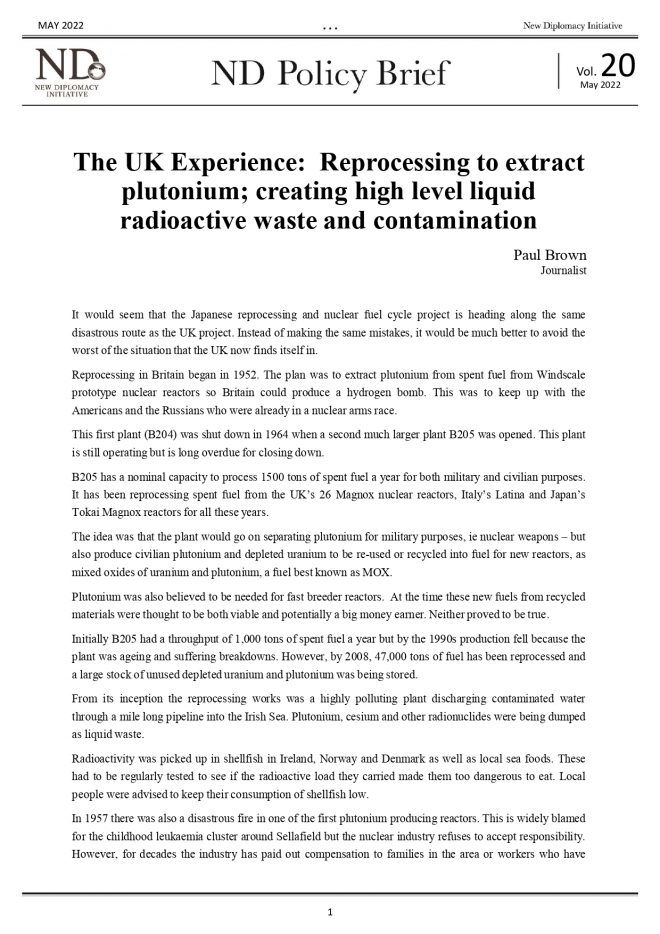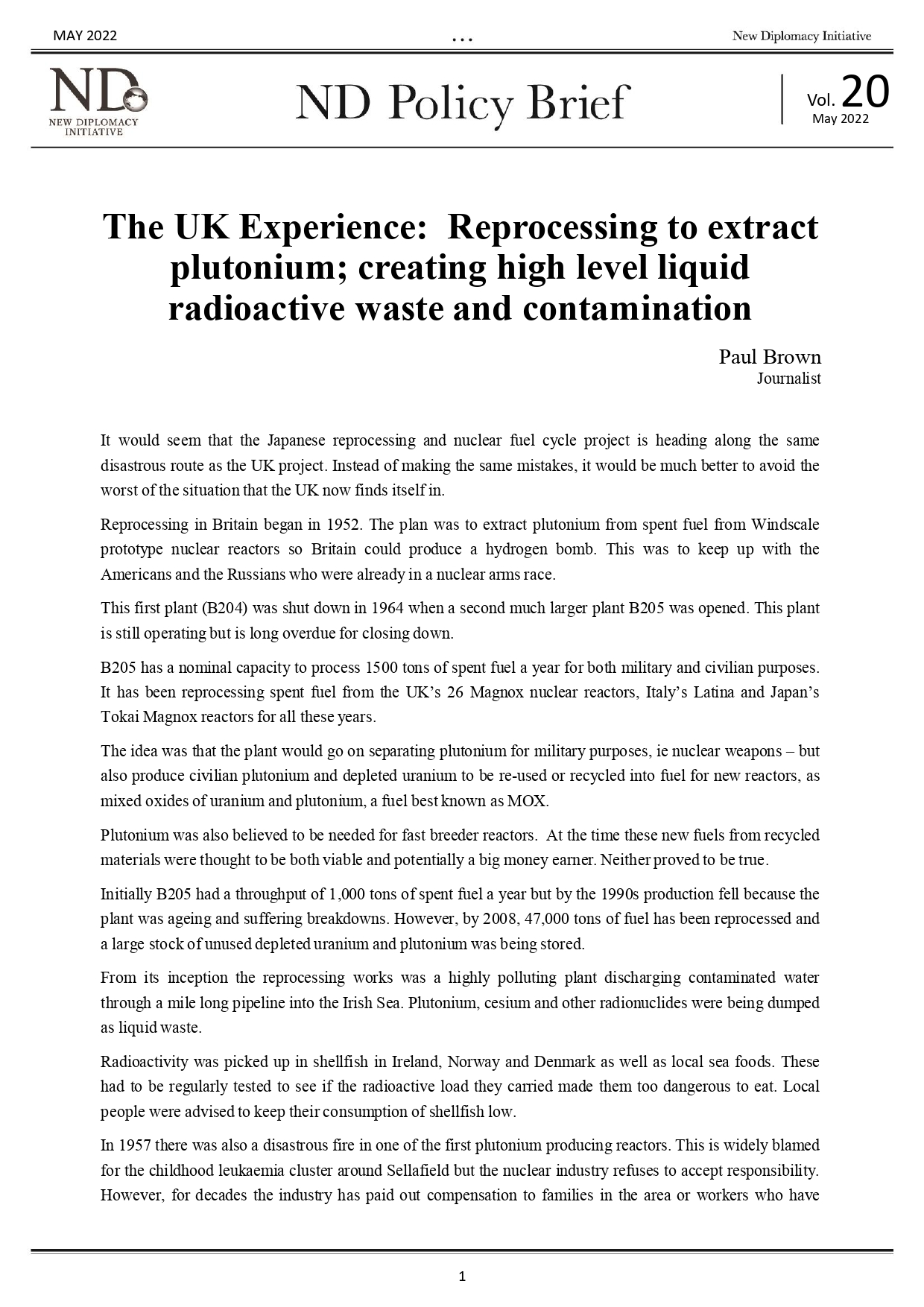Paul Brown
Journalist
It would seem that the Japanese reprocessing and nuclear fuel cycle project is heading along the same disastrous route as the UK project. Instead of making the same mistakes, it would be much better to avoid the worst of the situation that the UK now finds itself in.
Reprocessing in Britain began in 1952. The plan was to extract plutonium from spent fuel from Windscale prototype nuclear reactors so Britain could produce a hydrogen bomb. This was to keep up with the Americans and the Russians who were already in a nuclear arms race.
This first plant (B204) was shut down in 1964 when a second much larger plant B205 was opened. This plant is still operating but is long overdue for closing down.
B205 has a nominal capacity to process 1500 tons of spent fuel a year for both military and civilian purposes. It has been reprocessing spent fuel from the UK’s 26 Magnox nuclear reactors, Italy’s Latina and Japan’s Tokai Magnox reactors for all these years.
The idea was that the plant would go on separating plutonium for military purposes, ie nuclear weapons – but also produce civilian plutonium and depleted uranium to be re-used or recycled into fuel for new reactors, as mixed oxides of uranium and plutonium, a fuel best known as MOX.
Plutonium was also believed to be needed for fast breeder reactors. At the time these new fuels from recycled materials were thought to be both viable and potentially a big money earner. Neither proved to be true.
Initially B205 had a throughput of 1,000 tons of spent fuel a year but by the 1990s production fell because the plant was ageing and suffering breakdowns. However, by 2008, 47,000 tons of fuel has been reprocessed and a large stock of unused depleted uranium and plutonium was being stored.
From its inception the reprocessing works was a highly polluting plant discharging contaminated water through a mile long pipeline into the Irish Sea. Plutonium, cesium and other radionuclides were being dumped as liquid waste.
Radioactivity was picked up in shellfish in Ireland, Norway and Denmark as well as local sea foods. These had to be regularly tested to see if the radioactive load they carried made them too dangerous to eat. Local people were advised to keep their consumption of shellfish low.
In 1957 there was also a disastrous fire in one of the first plutonium producing reactors. This is widely blamed for the childhood leukaemia cluster around Sellafield but the nuclear industry refuses to accept responsibility. However, for decades the industry has paid out compensation to families in the area or workers who have died of cancer, as long as they sign a non-disclosure agreement.
Despite promises to close this polluting plant made for 2012, 2018 and 2020 it is still in operation today. Excuses for keeping it running have included many breakdowns but also more recently the Covid crisis.
In addition to these two reprocessing plant a third plant called a “re-cycling project” was planned in 1977. The Thermal Oxide Reprocessing Plant (THORP) was expected to make money on the then projected expansion of nuclear power. It was to provide plutonium and recycled uranium for newer reactors and for the still hoped for fast breeder reactor programme, which as we now know, never happened.
After a long public inquiry the UK government approval was given nine years later by which time contracts for reprocessing spent fuel had been made with a number of foreign companies.
THORP was finally completed in 1992 with costs having escalated from £300 million ($400 million) estimated in 1978 to £2.3 billion ($3.1 billion). By the time reprocessing began in 1994 British Nuclear Fuels, which at that time ran the site, had contracts to reprocess 7,000 tonnes of fuel. The biggest single customer was Japan, which contracted to have 2,673 tonnes reprocessed from its light water reactors. There were eight other countries with orders including Germany and Switzerland.
The plant was designed for a throughput of 1200 tons a year but never achieved that. After a slow beginning it reached 900 tons after four years but then slipped back and there were a series of acid spills, pipe leaks and blockages and problems with the plant’s sole high-level waste evaporator.
The worst accident was discovered in April 2005 when 22 tons of dissolved fuel and nitric acid was discovered to have leaked from fractured pipework into another part of the plant. It caused the plant to close for three years for repairs and overseas customers, including Japan, faced the prospect of their fuel being reprocessed 11 years late.
The plant finally closed in November, 2018 having reprocessed 9331 tons of fuel in 24 years, only one third of its design throughput.
As mentioned earlier the purpose of reprocessing, apart from providing material for nuclear weapons for the UK and sometimes also for the USA, was to provide new fuels for nuclear reactors. This plan has been a complete failure.
Between 1963 and 1988, a period of 25 years, about 20 tons of MOX fuel was produced at Sellafield – this is a tiny fraction of the total material stockpiled because of reprocessing.
In order to step up production, a MOX demonstration facility was built and opened in 1993 with an annual production capacity of 8 tons a year. No MOX was to be used in British reactors but orders were secured from Japan, Germany and Switzerland. The plant did not work as well as planned and only 16 tons were produced over five years. Still worse was the fact that when the last order for MOX reached Japan it was revealed in Britain that Quality Assurance Data, accompanying the fuel, had been falsified by bored night workers.
This caused a severe disruption in the relationship between the nuclear companies in Britain and Japan. £133 million ($177 million) was paid in compensation. In addition the UK plant was closed permanently and the suspect fuel returned to Britain.
Despite this setback British Nuclear Fuels constructed a much bigger plant to make more MOX fuel. They claimed the plant would produce 120 tons of MOX fuel a year by recycling the uranium and plutonium being produced by its THORP reprocessing plant. The idea was that the plutonium and uranium being produced by reprocessing would be fed directly into the new fuel.
Despite a cost of £490 million ($652 million) and a planned lifetime of 20 years the plant never worked properly. The plan was to produce fuel containing 10 per cent plutonium to use up the stocks being produced by THORP.
Japan still stung by the earlier scandal refused to order any MOX but some European utilities ordered fuel. In the event the plant never got anywhere near its advertised output. Plans were downgraded from 120 tons a year to 40 tons a year. In the end, performance was even worse 2.3 tons in 2005/6 and 2.6 tons in 2006/7.
After years of disastrous technical problems the plant had only produced five tons of usable fuel. It closed in 2011 costing 600 jobs and the British taxpayer £1.4 billion ( $1.7 billion).
Curiously despite these huge investments there has never been any plans to use MOX in British reactors and there is still none. It is just too expensive to produce.
Despite the fact it was producing plutonium and uranium that had no end use the THORP reprocessing plant continued its work. It was still making money dissolving spent fuel from foreign orders including those of Japan. It finally closed in 2018.
The plan now is to use this vast and redundant building, which is two kilometers long, to store British spent nuclear fuel until 2070.
To an outsider the enormous cost of running reprocessing works that produces plutonium and uranium that has no use and is then stockpiled is hard to understand or justify.
Reprocessing also produces dangerous waste. The most difficult to deal with is heat generating liquid waste left over after the uranium and plutonium is separated from the spent fuel by dissolving it in concentrated nitric acid.
This has caused severe problems at Sellafield where the tanks storing the waste were corroded. To tackle the problem the waste has been evaporated, mixed with glass matrix at 1150 degrees centigrade to make into vitrified blocks. These evaporators proved technically challenging to operate and maintain and frequently broke down.
At first only one was built but it worked so slowly more have been added. They have taken years to get working as originally envisaged. There are now many thousands of highly radioactive glass blocks in store. About 1,000 of these will be returned to Japan.
There is still no disposal route for these giant glass boxes anywhere in the world.
Perhaps the last part of this saga of failed nuclear reprocessing ambition is the legacy left behind at Sellafield.
There are upwards of 400 buildings containing nuclear contamination that all need to be dismantled safely.
There is the world’s largest stockpile of plutonium – about 140 tonnes – enough to make thousands of nuclear weapons – heavily guarded by armed police, in a special compound surrounded by three razor wired fences.
Some 112 tons of this plutonium belong to the UK and the rest to other countries including Japan, which have had fuel reprocessed at Sellafield. Britain continues to offer to take ownership of Japan’s plutonium – providing Japan pays enough compensation.
There are also more than 99,000 tons of spent uranium recovered in re-processing for which there is no current use. There are also 6,100 tons of spent fuel in reactors or in stores that has not been reprocessed and now never will be.
As a result of nuclear activities around the reprocessing works at Sellafield there are 6.3 million cubic metres of radioactive soil.
There is a whole industry needed to make safe the remaining high level liquid waste, medium level and low level waste.
Some of this waste will remain dangerous for thousands of years. The UK like so many other nuclear countries has so far found no way of disposing of the most dangerous wastes. Attempts to find an underground disposal facility have been going on for 40 years without success and still continue.
Currently it is costing British taxpayers £3 billion ($4 billion) a year to keep the waste at Sellafield safe. The site employs more than 6,000 people just to do this – producing no electricity or anything useful. It is expected to be 100 years before everything on the site can be made safe.
Meanwhile no decision has been made about what to do with all the plutonium and uranium left over from 60 years of reprocessing. It is still regarded by the British government as an asset not a waste – but there is no stated purpose for keeping it and no plans to use it.
※This paper is based on the author’s presentation at the international symposium “Growing Plutonium Stockpiles and the Rokkasho Reprocessing Plant: Reality of Nuclear Fuel Cycle and Security in East Asia” , Dec. 18-19, 2021. The views expressed here are those of the author.
※This project is supported by a grant from “act beyond trust” (abt) .




